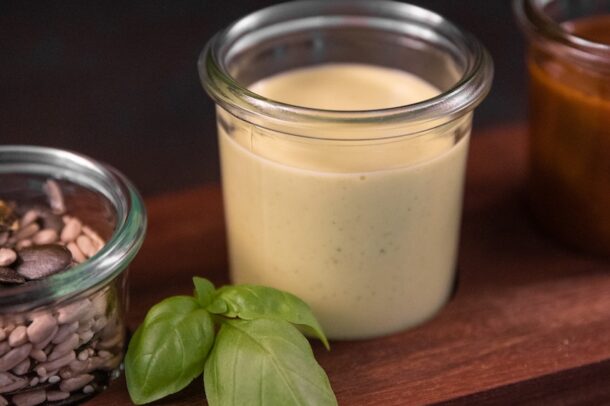By June Martin, RD
There are many reasons to make your own salad dressing! They are healthy, shockingly easy, incredibly versatile and so inexpensive.
Most Canadians get a tremendous amount of salt from condiments and salad dressing is a huge contributor to this. Taking a walk through my local grocery store. I saw a range in sodium levels from 130-280mg of sodium per tablespoon in common brands and flavours. These sources of added sodium can add up quickly! What I was truly surprised at was the number of products with added potassium (typically as potassium chloride). Potassium chloride is often used as a salt substitute because it has a similar flavour to sodium chloride. For kidney patients, this well-absorbed potassium additive can be dangerous. So if you are going to purchase your salad dressing make sure to look at the ingredients list as well as the sodium content.
As grocery prices continue to rise, it’s no surprise that salad dressings are getting more expensive too. Homemade dressing is cost-effective and while it doesn’t last as long as commercial dressings, you only need to make what you will use. Keep a small jar handy for throwing the ingredients into, and then shake until it all comes together!
Salads are a fantastic way to increase your vegetable intake but adding a commercial salad dressing can take away some of the health benefits that you’re trying to achieve. Making your own salad dressing gives you control over the ingredients. Sometimes recipes for homemade salad dressing look overwhelming and expensive, but in truth, most ingredients can easily be replaced with what you have in your pantry. If you don’t have fresh herbs on hand, use a pinch of dried. If a recipe calls for champagne vinegar, it will still be delicious made with white or red wine vinegar.
The classic ratio of oil to vinegar is 3:1, but you can adjust this to your taste. I like my salad dressing a bit zippier, so I am more likely to do a 2:1 ratio. Experiment with different vinegars (red wine vinegar, balsamic vinegar, rice wine vinegar or even use half lemon juice). Olive oil is the standard oil in most homemade salad dressings, but if you are craving a creamy dressing, replace part of the olive oil with mayonnaise, plain yogurt, or sour cream. Dijon mustard is a great add-in that will emulsify your dressing and add flavour.
Here are some basic recipes for making your own salad dressings with no preservatives, no added salt, and lots of flavour.
Balsamic Vinaigrette:
1/2c olive oil
1/4c balsamic vinegar
1 tsp honey or sugar
1 clove garlic, minced
½ tsp freshly ground pepper
Combine ingredients in a jar with a tightly fitting lid and shake until mixed.
Shallot Vinaigrette
2/3 cup extra virgin olive oil
1 shallot minced
3 tbsp red wine vinegar
cracked black pepper
1 tsp Dijon mustard
Whisk all ingredients together.
Tarragon Vinaigrette:
1 tsp Dijon mustard
2 tbsp lemon juice
2 tbsp white wine vinegar
1 tbsp minced shallot
2 tbsp fresh tarragon or 1 tsp dried tarragon
1/3 cup extra virgin olive oil
Mince shallots. Add mustard, tarragon, lemon juice, and vinegar. Whisk in olive oil. Drizzle over greens.
Warm Mushroom Salad With Watercress
4 tbsp olive oil
2 tbsp balsamic vinegar
1/2 tsp thyme
1 cup assorted wild mushrooms
1/2 c shallots
4 cups mixed greens (including watercress)
Saute mushrooms and shallots in olive oil. Season with thyme and finish
with balsamic vinegar. Serve over a bed of greens. Serves 4.
Recipes by Chef Leslie Cairns.
